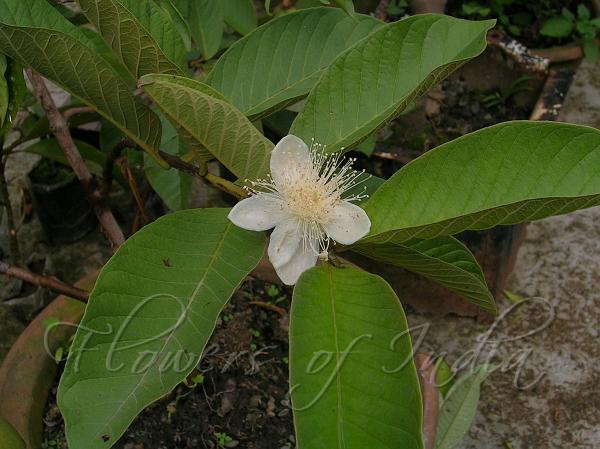|
| Guava |
|

|

| File size | 693926 |
| Original date | 7/10/05 2:51 PM |
| Resolution | 2048 x 1536 |
| Flash | Flash did not fire, auto |
| Focal length | 8.0mm |
| Exposure time | 1/251s |
| Aperture | 5.5 |
| Focus Distance | |
| Metering Mode | Partial |
| Camera make | NIKON |
| Camera model | E3700 |
| Sensor type |
|
|
|
|
Photo: |
Botanical name: Psidium guajava Family: Myrtaceae (Bottlebrush family)
Synonyms: Psidium fragrans, Psidium pomiferum, Psidium cujavus
Synonyms: Psidium fragrans, Psidium pomiferum, Psidium cujavus
Guava is a small tree, up to 33 ft tall, with
spreading branches, easily recognized because of its smooth, thin,
copper-colored bark that flakes off, showing the greenish layer
beneath; and also because of the attractive, "bony" aspect of its trunk
which may in time attain a diameter of 10 in. Faintly fragrant white
flowers, borne singly or in small clusters in the leaf axils, are 2.5
across, with 4 or 5 white petals which are quickly shed, and a
prominent tuft of about very many white stamens tipped with pale-yellow
anthers. The fruit, exuding a strong, sweet, musky odor when ripe, may
be round, ovoid, or pear-shaped, 5-10 cm long, with 4 or 5 protruding
sepals at the top, and thin, light-yellow skin, frequently blushed with
pink. Guava is native to the Caribbean, Central America and South
America, widely cultivated across the world.
Medicinal uses: Fresh leaves of about 500 gms
are boiled in 200ml of water for 10 minutes. The decoction is drenched
twice daily for 4-5 days to cattle as cure for dysentery.
Fresh leaves of about 500 gms
are boiled in 200ml of water for 10 minutes. The decoction is drenched
twice daily for 4-5 days to cattle as cure for dysentery.
Medicinal uses:
 Fresh leaves of about 500 gms
are boiled in 200ml of water for 10 minutes. The decoction is drenched
twice daily for 4-5 days to cattle as cure for dysentery.
Fresh leaves of about 500 gms
are boiled in 200ml of water for 10 minutes. The decoction is drenched
twice daily for 4-5 days to cattle as cure for dysentery. | Identification credit: Thingnam Girija | Photographed in Imphal, Manipur. |
• Is this flower misidentified? If yes,